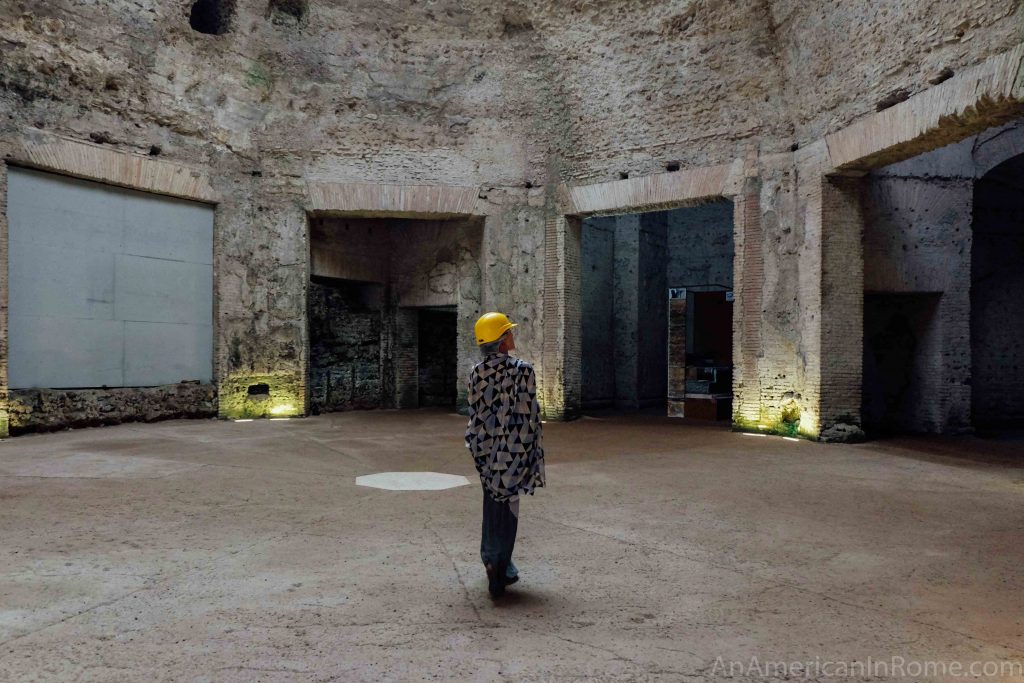With the iconic ruins of the Colosseum, the fallen temples of the Roman Forum and the open oculus of the Pantheon scattered throughout the heart of the center, Rome is essentially a glorious open-air museum. However, some of the best ancient sites are hidden just below the surface or tucked away in the city’s quieter corners.
Here is where to find the most beautiful secret Roman ruins:
Domus Aurea
Nero’s Golden Palace was one of the most incredible buildings constructed in Ancient Rome. It was made possible thanks to a massive fire that wiped out most of the city in 64 AD. After reportedly playing the fiddle while Rome burned, Nero took advantage of all the space the destructive blaze left behind to build himself the greatest palace the world had ever seen. The Domus Aurea, sometimes known as Nero’s Golden Palace, was set atop the Caelian Hill and its grounds stretched over more than 300 acres. The palace itself was covered in marble and extraordinary frescoes but all of this was lost after Nero’s death.
The ostentatious Golden Palace was a bitter reminder of the lavish lifestyle the unpopular Emperor had led, so his successors buried the beautiful villa and bulldozed his artificial lake to build the Colosseum. The ruins of the Domus Aurea remained lost until the 15th century when a young Roman nearly fell through a hole in what turned out to be the palace’s ceiling. Excavation work is still ongoing but you can visit many of the main halls on an archeological tour, see examples of the once-great artwork, and take part in a virtual reality experience to get a sense of the former grandeur.

Pyramid of Cestius
The Romans were enamored with Egyptian culture and as their empire grew, the ancient emperors helped themselves to Egypt’s obelisks. The hieroglyph-covered pillars can still be spotted around the city, but the most interesting example of the Egyptian influence can be found at the edge of the less-visited Testaccio neighborhood – a towering pyramid. The monument was built as a tomb for Gaius Cestius, a wealthy Roman citizen, in 12 BC. The structure was later incorporated into the fortified walls that surrounded the city and has remained remarkably well preserved. There are occasional tours of the restored interior of the pyramid but the perfect sloping sides are more impressive from outside. After admiring the gleaming monument, keep following Via Marmorata to enjoy a pick-me-up at Tram Depot. The outdoor cart with cute park-like seating serves specialty coffee, as well as wine and cocktails later in the day.

Basilica of San Clemente
Some of the 900 churches in Rome house masterpieces from Bernini, tombs designed by Michelangelo, and museum-worthy paintings by Caravaggio, but the most interesting church in the Eternal City might very well be the Basilica of San Clemente. The small church is overshadowed by the Colosseum two blocks away, but it is well worth the detour to admire the 12th-century mosaic that glitters above the altar. However, the lovely medieval basilica is only the first level of the multi-layered building. The current structure was built directly on top of an earlier church which dates back to the 4th century. For a small admission fee, you can descend through the centuries to arrive at the true foundations of the building: far below the modern-day street is a hidden Mithraic temple. The altar of the cult is still visible and is one of the finest examples of an ancient Mithraeum in Rome and truly one of the city’s best hidden Roman ruins.

Arch of Janus
The Roman Forum is dotted with elaborately decorated but crumbling triumphal arches. In fact, the only surviving four-side arch in Rome sits a short walk away – quietly tucked away behind Circus Maximus. The Arch of Janus remains a bit of a mystery. It probably took its name during the Renaissance, called after the Roman god Janus who was sometimes depicted with four heads. However, it’s original name and function has been lost to history. The now-empty niches that cover the upper layer were likely once decorated with statues, and you can see a stone depicting Minerva on the north side of the stately arch. The white marble exterior, which soars to 16 meters tall, was recently restored but few visitors know about this hidden monument. Stop by the ancient arch and you may notice it is juxtaposed with a modern installation: a full-sized rhino sculpture which is a part of Alda Fendi’s experimental art space next door. The effect of the monument is most impressive at night when the unique quadrifrons arch is lit dramatically from below.

Parco degli Acquedotti
One of Rome’s most underexplored outdoor spaces, Parco degli Aquedotti offers a taste of the grandeur of Rome’s famous aqueducts. Virtually tourist-free, locals know that this section of Parco dell’Appia Antica is an ideal spot for enjoying Rome’s near-perfect weather. Massive and well-preserved aqueducts cut across green hills, sometimes past modern suburb housing. The large grassy areas under the aqueducts are filled with picnicking families on the weekends, but you can also rent a bike to explore the park. The aqueducts themselves date to two different eras, but the most imposing are the ruins of the Aqua Claudia, which was completed in 52 AD. The stone structure stretched 69 kilometers (43 miles) to bring fresh water from the countryside to the citizens of Rome.







Thanks for this list. I’ve missed the Domus Aurea and the aqueducts but agree that the San Clemente mosaics are quite beautiful.
Great ideas. S Clemente, in particular, is well worth a visit. I’d add Quartiere Coppede… interesting architecture…
Agree re Quartiere Coppede – gorgeous Art Nouveau architecture.
Such a unique area!
Ostia Antica was also very interesting!
Yes! Ostia Antica is really such a gem, and pretty close to the city!